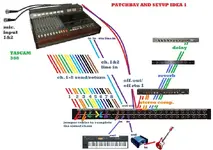H
hansgauffin
New member
Hi, I´m in the process of setting up an analog home recording studio and want some reflections upon my idea. I know i´ll need a Patchbay for this project but I am unsure of which type of patchbay to look after. Please look at the attached picture and help me decide which patchbay that would fit my needs. I am quite unsure if the various connections would actually work out in the real world, especially when it comes to mono line in instruments, can you use just ONE input on each side of the patchbay (upper front/upper rear?).and if there are other better solutions, please feel free to make your opinion.
I know I´m gonna use unbalanced 1/4 cables for this patchbay.
Thank you for helping me out.
I know I´m gonna use unbalanced 1/4 cables for this patchbay.
Thank you for helping me out.


 ... can you explain this a little bit further, sounds interesting.
... can you explain this a little bit further, sounds interesting.
 But I don't know for sure that is the cause.
But I don't know for sure that is the cause.